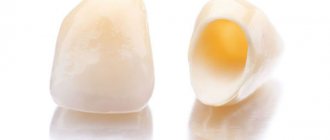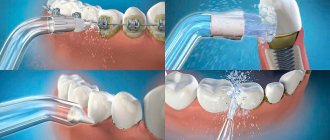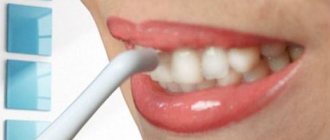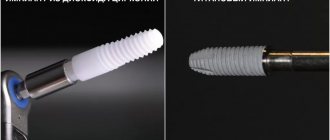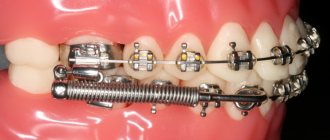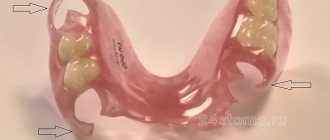In dental implantation, a very important point is the initial planning and selection of an orthopedic design, including crowns for implants. It is for this reason that in our SDent clinic, the initial examination and consultation is carried out not by an implantologist, but by an orthopedic dentist.
In order to correctly distribute the subsequent load on the teeth, the orthopedist clearly determines which dental implants to place, as well as the location and number of implants. Only after this does the implantologist give his opinion on the choice of types of implants, implantation techniques and the possibility of performing an operation without prior preparation for bone augmentation.
Unfortunately, it happens that some implantologists offer to install implants “without problems and quickly”, without taking into account all the subtleties of this process in combination with prosthetics.
A tooth on an implant consists of three parts: the artificial root itself - the implant, an abutment, which is inserted into the implant and serves as a supporting stump for the crown on top.
Crowns for implants differ in the material from which they are made and in the type of fixation to the implant.
In what cases are crowns placed on implants?
When they talk about crowns on dental implants, they mean that single defects will be restored. For example, if 1-2 teeth in the neighborhood are missing, then each missing root will be replaced with an implant, and a crown will be placed on top of the implants. If several teeth are missing in different parts of the row, i.e. healthy teeth alternate with missing ones - then do the same as in the previous case.
But when 3 or more teeth in a row are missing, the best option would be to install a bridge on implants. But crowns are also possible - if the level of the gum[1] allows this, and the patient himself wants just such prostheses, however, the cost of treatment here will be significantly more expensive. In case of complete absence of teeth, from 3 to 8-10 implants are placed, and an extended prosthesis is fixed on them. Moreover, in most cases it will consist not only of crowns, but also artificial gums and a frame (if necessary). In a situation with a bridge or an extended prosthesis, special fasteners are created in the base of the structure, which are fixed on abutments or on beams.
New teeth in 1 day - All-ON-4 - 180,000 rub.
All inclusive!
3D modeling of the structure with a prosthesis, implantation of 4 Osstem implants, installation of a fixed prosthesis on the same day. Free consultation with an implantologist +7 (495) 215-52-31 or write to us
Read on the topic: what are abutments - complete information about the “adapters” between implants and dentures.
Does it hurt during implantation?
All procedures are carried out under local anesthesia, so the patient does not experience any painful sensations - he only feels the mechanical work of the doctor in the mouth, as during conventional dental treatment. In fact, the manipulations performed when installing an artificial root are less invasive and traumatic than when removing a tooth.
If you are very worried and are terrified of the upcoming operation, the clinic may offer implantation under sedation - in a relaxed state, but in full consciousness. The patient is given drugs that put him into a light sleep and he ceases to experience anxiety.
Types of crowns for implants
Before talking about which crowns are best for implantation, you need to look at the types that can be placed on implants. Because the type of prosthesis offered to the patient is selected depending on the indications and wishes (aesthetics, service life, cost, etc.).
By service life – temporary and permanent
It should be understood that prosthetics after installation of implants can occur at different periods of time. For example, with delayed loading of the prosthesis, a permanent crown will be placed 3-6 months after implantation. Here you need to wait for the implant to take root completely, i.e. bone substance has grown on it. With early loading (when implants with active surfaces that stimulate bone growth are used), a permanent prosthesis will be installed in 2-4 weeks.
But after all, all this time a person will not want to walk around with a “gap” in the dentition - especially if the defect falls into the “smile zone”. Therefore, before its engraftment, a light temporary crown is placed on the implant, removed from the bite, so that through it there is no pressure on the intraosseous part (otherwise engraftment will be in question). Its service life is usually up to six months. And after engraftment, a durable and highly aesthetic permanent is installed, which will last 10-15-25 years, depending on the material and how you use it.
There is also implantation with immediate loading, when a temporary and even permanent prosthesis is installed 3-7 days after the surgical stage. You can immediately load a prosthesis on 3 or more implants in a row (segments of teeth or extended prosthetic structures are suitable here). Additionally, the prosthesis is equipped with a metal beam for splinting implants. But for single crowns this method is not relevant.
By materials and their combinations
Which crown is better to put on an implant? The strength and aesthetic properties of materials are of great importance in determining what kind of orthopedic construction it will be - temporary or permanent, for the front or chewing tooth, how long it will last and whether it will provoke complications. Now metal, ceramics, plastic, zirconium dioxide, aluminum oxide, and nanomaterials (for example, ceramic composite) are used for prosthetics.
Pure ceramics are not used for crowns on implants. Because it is very fragile compared to the material for abutments (these are metals or zirconium dioxide) and after a short time it will simply crack from chewing pressure. People also try not to use pure metal or alloys without an aesthetic coating because of their unsightly appearance, because... metals with the “color of natural teeth” simply do not exist.
Plastic and metal-plastic
A plastic crown on an implant is used as a temporary option after implantation, just like a metal-plastic one. The difference is that the plastic one consists of one material - usually acrylic, which can be reinforced with diamond chips for strength. And metal-plastic is a metal cap (usually made of a nickel alloy), lined plastic can also be included in bridges and complete temporary/adaptive dentures.
The advantages of the material are that it is lightweight, white, easy to repair and inexpensive to produce. The disadvantages of plastic include fragility, the presence of pores on the surface (so odors and dyes are quickly absorbed), allergenicity and a short service life. Pure plastic will last only a few weeks or months, but metal plastic will last 3-5 years with proper care.
Ceramic composite and metal composite
Ceramic composite is a combination of ceramics and composite material, used in dentistry relatively recently. However, the material has already received high marks from orthopedic dentists due to its high aesthetics, good strength and maintainability. The service life depends on the qualities of the ceramics and composite; if the material is made by a trusted manufacturer - for example, Ivoclar Vivadent, then such a product can last about 20 years.
A metal-composite product is a metal cap coated with a layer of light-curing composite or photopolymer (dental fillings are made from this composition). Metal composite is a lightweight material, but more durable than metal-plastic. However, it is still susceptible to chipping, but they can be built up directly in the patient’s mouth (without removing the denture). Service life is about 5 years.
Metal ceramics
Metal-ceramic crowns on implants are the most common for permanent wear (their service life is at least 10-15 years). They are also considered the “golden mean” in terms of quality and price. Strength, bioinertness and aesthetics directly depend on the material. For example, if for the metal base you take not a nickel or cobalt-chromium alloy, but titanium, gold or palladium, then not only the strength increases, but also the risk of allergies decreases. And metal bases cast in the usual way are less durable than those milled on high-precision machines.
It is worth mentioning the ceramics that will be used to cover the metal base. The higher quality it is, the better the result will be - the ceramic layer will not chip over time and will not be stained by coffee or berries. Experienced orthopedists choose materials whose quality has been tested by time. For example, fluorapatite-reinforced leucite ceramics IPS d.SIGN, IPS Style with oxyapatite or IPS Classic from Ivoclar Vivadent. Materials from VITA Zahnfabric have also proven themselves well - feldspathic ceramics VITAVM 13 and VMK Master for cladding frames made of any metal.
Read on the topic: the most detailed information about dental crowns made of metal ceramics - what they are, and which one is better to install.
Metal-ceramic dentures also have disadvantages - the likelihood that the metal base will be visible through the translucent layer of ceramics, and the restoration will take on a lifeless gray color. The problem is solved by replacing the gray metal with “yellow” gold or palladium, but their cost is quite high. Also, the gums at the point of contact with the metal may become “cyanotic” - which will look especially unaesthetic in the “smile zone”. Another drawback is that if a chip appears, it is impossible to build up a ceramic layer using the direct method, i.e. It is impossible to do without removing the prosthesis for repairs. In addition, when choosing inexpensive alloys for the base, galvanic syndrome may occur.
Zirconium dioxide
Despite the fact that zirconium dioxide crowns on implants appeared relatively recently - about 15-20 years ago, they quickly took a leading position due to their special properties. Zirconium dioxide combines the best qualities of all known materials, and at the same time their service life is more than 25 years.
The disadvantage of zirconium dioxide is its high cost, which is due not only to the complex production of the material, but also to the processing features. It is impossible to grind it manually due to its high strength, so zirconium dioxide prostheses are made only by milling. Also, many manufacturers produce pure white zirconium dioxide with an opaque structure - so the new tooth may look too white and unnatural. The problem is solved by lining or pressing aesthetic and translucent ceramics onto a zirconium base. Popular manufacturers and brands are PRETTAU (Anterior, Dispersive, Zirkon), Noritake CZR, Ivoclar Vivadent (hybrid material ZirCAD Prime and the well-known IPS e.max ZirPress, IPS e.max ZirCAD in combination with IPS e.max Ceram).
According to the method of fixation on the abutment
- cement fixation: the oldest and simplest method, which involves fastening the orthopedic structure and abutment with cement. But if the prosthesis has to be removed for some reason, then it will not be possible to do without “losses” - you will need to saw the crown on the implant, and then replace it with a new one,
- screw fixation: a more modern method, but it requires high professionalism from dentists and more time to work with the patient. At the same time, the components themselves are more expensive. The point is that the connection occurs using a miniature screw - it is inserted through a hole in the “cap” and screwed into the abutment. And from above, the recess in the prosthesis is filled with a light-colored, light-curing composite. Here, to remove the prosthesis for repair or access to the abutment, you just need to drill out the “seal” and unscrew the screw. The prosthesis itself is not damaged, and it can be put back without replacing it with a new one.
Which fixation method is better - cement or screw?
Currently, dentists often prefer the screw method of fixation, because it allows you to remove the prosthesis multiple times without damaging it. There are also fewer restrictions on the width of the gum and the height of the abutment - for example, to fix the structure on cement, the abutment must be at least 5 mm, and the attached gum must be at least 3-4 mm in height. But the cement method is not becoming a thing of the past.
Surgical stage
Purpose: preparation of the site for implant installation, implantation of an artificial root, formation of the correct gum contour.
Under local anesthesia, the implantologist sequentially performs the following 4 surgical procedures:
Dissection of gum tissue
To gain access to the bone of the lower or upper jaw, the doctor makes a small incision in the gum and removes the flaps.
Formation of a landing channel for an implant
Using a surgical template, the doctor drills a channel of the required depth and width into the spongy tissue.
The doctor measures the resulting depth of the canal in the bone tissue and compares it with the required value.
Performs smooth boring of the channel to the planned width. Drills of different diameters are used sequentially.
Fixation of titanium rod
An implant is placed in the hole.
First, the artificial root is implanted using an electrical device. It is then screwed in by hand until it matches the edge of the bone.
The implant is closed with a temporary plug.
Gum suturing
The edges of the incisions are sutured to close the plug.
After the implant has healed (3-4 months on the lower jaw and 4-6 months on the upper jaw), to give the gum an aesthetic contour, the plug is removed and a gum former is placed.
A maximum of 14 days after installation of the gum former, it is replaced with an abutment - the connecting link between the implant and the orthopedic structure.
A temporary coping is placed on the abutment for taking impressions.
Advantages and disadvantages of crowns on implants
The advantages of crowns on implants are as follows:
- high restoration aesthetics: a beautiful gum contour is formed around the dentures, so they look like real teeth,
- long service life: minimum 10 years, maximum 25 years or more. While classic ones last on average 5-7 years on your own teeth. This is explained by the fact that caries appears in the natural roots under the prosthesis, or due to overload there is increased pressure on the bone (this leads to inflammation at the roots), or cracks form on the roots. While the service life of the implant is eternal, and caries cannot appear in it,
- quick adaptation and wearing comfort: a person feels the new artificial teeth as if they were their own,
- ease of use and care: you can eat any food without restrictions (but, of course, without “fanaticism” - you shouldn’t chew candies and nut shells), and for cleaning, a regular toothbrush and paste are enough,
- there is no need to grind down adjacent teeth and remove nerves from them (as is required for classic bridge structures),
- possibility of immediate recovery (simultaneous implantation): if the patient has diseased teeth or roots that need to be removed as planned, then an implant can be installed and prosthetics can be performed directly on the day of removal.
There are practically no disadvantages to crowns on implants; the only thing worth paying attention to is to responsibly choose the clinic and doctor where you plan to have implantation done. After all, 90% of the success of treatment depends on how correctly the implants are selected and installed, as well as how the prostheses are modeled, manufactured and fixed.
Complications - when should you see a doctor?
If you experience any of the following symptoms, contact your doctor as soon as possible:
- After the 3rd day of surgery, pain gradually increases
. It is quite normal to experience minor pain for the first 2-3 days, but no more. - On the 4th day the swelling began to increase with an increase in body temperature
. Normally, it should subside on the third day. If it grows, then there is a problem. - After 4-5 hours, the surgical wound continues to bleed
. Minor bleeding in the first 2-3 hours is normal. But you should be wary if the wound continues to bleed. - Part of the face became numb, and there were difficulties opening the mouth
. This is due to stretch/compression or injury to the nerve. It occurs very rarely (in less than 3% of patients) and is associated with physician error. - The temperature rose sharply to 39° on the fourth day
. An increase in body temperature to 38° in the first three days after surgery is a completely normal reaction of the body to surgery. But if after three days you notice a sharp increase in temperature, then you need to consult a doctor. - Purulent discharge appeared from the implant site
. This indicates the presence of an inflammatory process due to infection of the hole.
How are prostheses made and installed?
Modern technologies are closely intertwined with dentistry and have given it the following opportunities:
- instead of conventional impressions, digital scanning of the oral cavity is carried out using intraoral 3D scanners, and the data is immediately sent to a computer - to a specialized program for creating a model of the prosthesis,
- modeling a perfect smile even at the stage of preparation for implantation (for example, using the Digital Smile Design concept),
- milling of prosthetic bases on high-precision machines: allows you to create a perfectly adjacent structure - both to the abutment and to the opposite teeth when the jaws are closed.
If we consider the installation in a simplified version, then after fixing the abutments, impressions are taken, then a model is created in the laboratory - and a prosthesis is already made on its basis. Then it is tried on, and if the doctor and the patient are satisfied with everything, then the structure is permanently attached (with screws or cement).
Choosing the best crown
Let's decide which crowns are best placed on implants. A good solution in terms of price and quality are metal-ceramic ones, but in the frontal zone they can lead to “blueness” of the gums. Therefore, the best option is zirconium dioxide. Their price may seem high to some, but it is fully compensated by their service life. After all, while you are wearing a zirconium dioxide prosthesis, the metal ceramics will have to be changed at least once - this is extra money and time.
“I definitely won’t get metal-ceramics for myself anymore, because it makes my gums look very ugly. I don't want to smile. Therefore, when the old bridges became loose and I had to put in implants, I immediately told the dentist that we’d better use zirconium. Honestly, I’ve been wearing new teeth for 2.5 years now and you can’t tell them apart from real ones, and my gums are fine.”
Svetlana A., 42 years old, review from irecommend.ru
Contraindications
| Absolute (operation impossible) | Relative (the operation is temporarily postponed) |
|
|
Cost of crowns for implants
How much does a crown for an implant cost? It can be difficult to understand the pricing policies of various dental clinics. Because, for example, implantation on an all-inclusive basis with a zirconium dioxide crown together with an implant and installation can cost 50-600 thousand rubles (on offer). And metal-ceramic, together with the implant and work, can cost 40-50 thousand rubles (without promotions from the clinic). Therefore, it is better to check prices at the chosen dentistry.
[1] Cardaropoli D. Soft tissues and pink aesthetics in implantology, 2021.
[2] Renvert S., Giovanielli J.-L. Peri-implantitis, 2014.
Author: Chorny S.V. (Thank you for your help in writing the article and the information provided)
